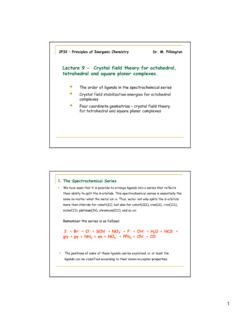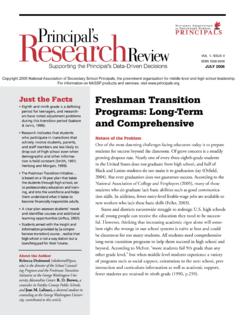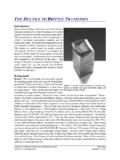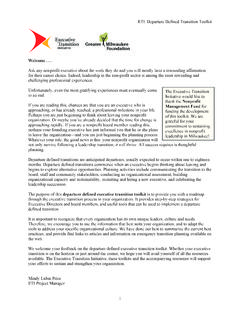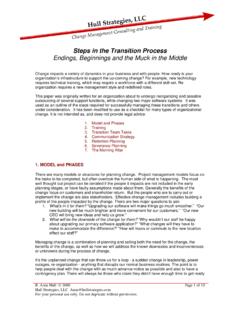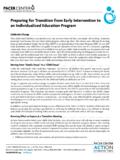Transcription of Lecture 5 - Stereochemistry in Transition Metal …
1 2P32 Principles of Inorganic Chemistry Dr. M. Pilkington Lecture 5 - Stereochemistry in Transition Metal complexes Transition T n iti n m Metal t l complexes mpl x as drugs- d why h understanding nd t ndin isomerism is important? Stereoisomers review from previous Lecture Geometric isomers of octahedral complexes Optical isomers of octahedral complexes Importance p of f isomerism consequences q of f a racemic drug 2. Stereoisomers in Metal complexes - Review Geometric Isomers are found in square planar and octahedral complexes . Examples p for square q planar p coordination are the cis- and trans- isomers of diamminedichloroplatinum(II): Note the convention of drawing a square with the Metal ion in the center and the ligands at the corners of the square.
2 1. An example of geometric isomers in octahedral complexes are the cis- and trans-isomers of the tetraamminedichlorocobalt(III) ion: Note that there are several different ways to represent an octahedrally coordinated Metal ion; which way you choose depends on what you are trying to show. Consider a trigonal bipyramid, in this case two positions differ from the other three. Lax For a coordination compound we draw it as: Leq Leq Mn+. Leq Lax Not equivalent 2. 1. Transition Metal complexes as Drugs Invesitgational New Drugs, December 1995, Volume 13, pages 327-332. Pt complexes have had the most effective medicinal properties against certain types of cancers, but in 1995 the first non platinum Transition Metal anitcancer agent (Budotitane) reached phase 2 clinical trials.
3 Maximum clinical dose of this compound is 230 mg/m2 twice weekly because the side effects of larger doses are cardiac arrhythmia. Budotitane is an anticancer agent that is active against a number of tumors but best at reducing the size of colon/rectal tumors. 2 geometric isomers of Budotitane are known one of which is chiral: 3 isomers known not chiral chiral This drug was withrawn from the market because there were too many isomers. (Why are pharmaceutical companies nervous of isomers?). Stereoisomers Geometric Optical 3. Geometric Isomerism for Some Common Octahedral Complex Compositions 1. Composition MA4B2 has 2 geometric isomers, cis and trans. We have already seen that there are two geometric isomers possible for this composition when the coordination geometry is octahedral: cis and trans.
4 The key is to not get confused by different ways of drawing these isomers. You should especially remember that all six positions on an octahedron are equivalent: there are not axial and equatorial positions as there are for a trigonal bipyramid. 3. For example, both drawings below represent the cis- tetraamminedichloroplatinum(IV) ion, in which the Cl-Pt-Cl bond angle is 90o: And both of these drawings represent the trans tetraamminedichloroplatinum(IV) ion, in which the Cl-Pt-Cl bond angle is 180o. 2. Composition MA3B3 has two geometric isomers, fac and mer. The fac- isomer (short for "facial") gets its name because all three chlorides are coordinated on one face of the octahedron. The mer- isomer (short for "meridional ) has the three chloride ions coordinated in a plane that includes the Metal ion.
5 (This corresponds to the p meridian on a sphere, which is anyy plane p through g the sphere p that contains the center.). fac-triamminetrichlorocobalt(III) mer-triamminetrichlorocobalt(III). All three Cl-Co-Cl bond angles are 90o. Two Cl-Co-Cl bond angles are 90o, the other is 180o. 4. 3. Composition MA2B2C2 has five geometric isomers. It's just a matter of working out all the cis and trans possibilities for each pair of ligands. Consider the cobalt complex [Co(NH3)2Cl2(NO2)2]-. cis-diammine-cis-dichloro-trans- trans-diammine-cis-dichloro-cis-di- di-N-nitritocobaltate(III) ion N-nitritocobaltate(III) ion cis-diammine-trans-dichloro-cis-di- cis-diammine-cis-dichloro-cis-di- N-nitritocobaltate(III) ion N-nitritocobaltate(III) ion trans-diammine-trans-dichloro-trans-di-N -nitritocobaltate(III) ion 4.
6 Composition M(A-B)3 has two geometric isomers, fac and mer. Here, A-B represents an unsymmetrical bidentate chelating agent such as the aminoethanethiolate ion, NH2CH2CH2S-, or the benzoylacetonate ion whose resonance forms are shown below. The donor atoms are different for aminoethanethiolate so it is clearly unsymmetrical. However, even though the donor atoms are same (both oxygens) for benzoylacetonate, the two "ends". ends of the chelating anion are different: one oxygen is close to a methyl group, the other to a phenyl group. resonance structures for benzoylacetonate fac-isomer, Co(bzac)3. Op is the oxygen mer-isomer, Co(bzac)3 . Here the Om's closest to the phenyl group, Om is the oxygen are all meridional, as are the Op's two closest to the methyl group.
7 All O-Co-O O-Co-O angles 900 and one 1800. angles are 900. 5. 5. Composition M(A-A)2B2 has two geometric isomers, cis and trans. Here, A-A represents a symmetrical bidentate ligand such as acetylacetonate (acac), oxalate (ox), or ethylenediamine (en). The isomers for [Co(en)2Cl2]+ are shown below. The N-N is ethylenediamine. cis-dichlorobis(ethylenediamine)cobalt(I II) ion trans-dichlorobis(ethylenediamine)cobalt (III) ion H H H H. N C C N. H H. H H. ethylenediamine (en). 1,2-diaminoethane IUPAC. 6. Composition M(A)B3 has two geometric isomers, fac and mer. Here, A represents a tridentate ligand such as diethylenetriamine. The isomers for [Co(dien)2Cl3] are shown below. The N-N-N is diethylenetriamine. Cl N. N Cl N Cl Co Co N N.
8 N Cl Cl Cl mer isomer fac isomer (all on one face). Consider [Co(dien)ABC] where ABC are three different ligands: The mer isomer has three possibilities B A A. N A N B N C. Co Co Co N N N N N. N. C C B. B trans to C A trans to C A trans to B. The fac isomer also has three possibilities so there are a total of 6. geometric isomers for [Co(dien)ABC]. 6. 7. M(trien)B2 has 3 geometric isomers. Trien is a linear tetradentate ligand, . The flexible trien ligand can coordinate to an octahedral center in 3. different ways as shown below for [Cr(trien)Cl2]+. Nm and Nt designate the middle NH groups and the terminal NH2 groups, groups respectively respectively, on the ligand Isomer A: both chlorides Isomer B: the chlorides Isomer C: one chloride is are trans to the middle are trans to each other trans to a middle nitrogens nitrogen, the other is trans to a terminal nitrogen.
9 4. Optical Isomerism Optical Isomers are usually associated with tetrahedral or octahedral geometries. The [Co(NH3)ClBrI]- ion is tetrahedral, with four different groups bonded to the cobalt, and has two nonsuperimposable mirror images: Thus this complex is exactly analogous to carbon compounds. It is also true that an octahedral Metal ion bonded to 6 different ligands would be chiral (there are no known examples of such a complex as far as I know): 7. Optical Isomerism for Some Common Octahedral Complex Compositions There are instances of chirality and optical isomerism that do not depend on having four different groups attached to a tetrahedral central atom. 1. M(A-A)3 has optical isomers. This means that any octahedral tris chelate, whether with a symmetrical or an unsymmetrical bidentate ligand, is chiral hi l and d will ill have h optical ti l isomers.
10 Is s For F example, l the th tris(ethylene- t is( th l diamine)cobalt(III) ion is chiral, in spite of the fact that the three ethylenediamine ligands are all the same and are themselves symmetrical: N N [Co(en)3] 3+ - the ligands are identical but they are chiral N N N N. Co Co N. N. N N. N. N. molecules . O ti l Isomers Optical Is s One of the alternate ways of showing the octahedron shows the right/left handed nature of these two isomers more clearly: The chelates define either a right handed helix (delta) or a left handed helix (lambda). Remember the twist of chirality On your cover a very rare sight, a helix that gave me a fright. Did you forget that this spiral called DNA is chiral, and it normally twists to the right?)


